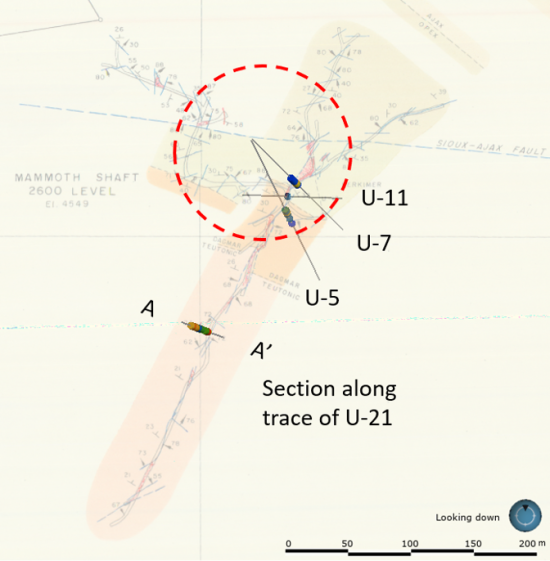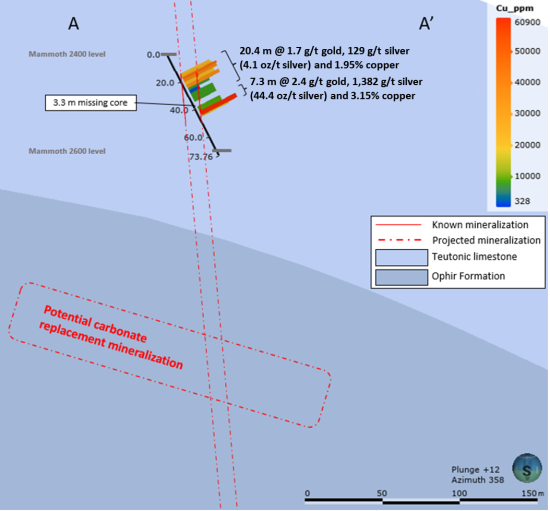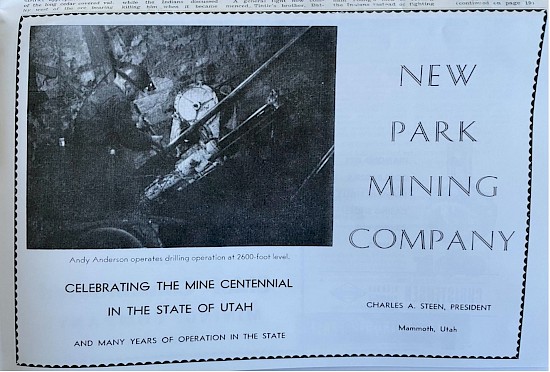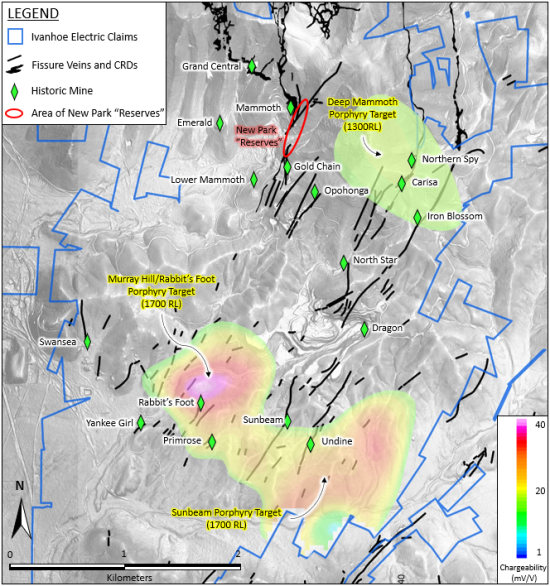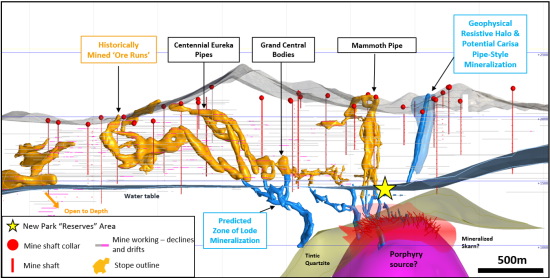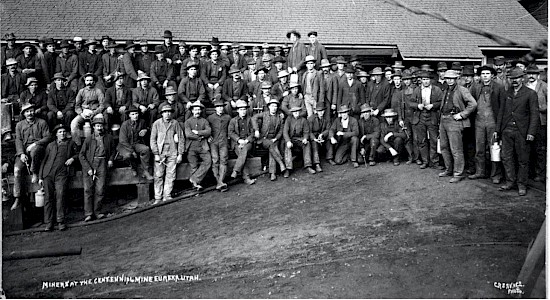Ivanhoe Electric provides an update on recent exploration activities at its Tintic Copper-Gold Project in Utah
September 20, 2022
Ivanhoe Electric provides an update on recent exploration activities at its Tintic Copper-Gold Project in Utah
New analysis of historic drill core confirms high-grade mineralization in the New Park “Reserves” area located below the past-producing prolific Mammoth Mine
Evidence of increasing copper grades and chalcocite in core samples indicate possible proximity to the porphyry source of Tintic mineralization
COLORADO SPRINGS, COLORADO – Ivanhoe Electric (NYSE American: IE; TSX: IE) Chairman and Chief Executive Officer Robert Friedland and President Eric Finlayson are pleased to provide an update on recent exploration activities at the Tintic Copper-Gold Project in Utah.
As part of the targeting program underway ahead of the future exploration drill program, Ivanhoe Electric has re-sampled drill core from a number of historic holes. Recent high-grade re-assay results have continued to enhance the Company’s understanding of the Tintic District and have shown that high-grade copper and precious metals mineralization may be present nearby to existing historic underground mine infrastructure.
Speaking at the Denver Gold Group – Gold Forum Americas today, Mr. Friedland commented: “We continue to be astounded by the high-grade mineral potential of the Tintic District. A lot of copper, gold, silver, lead and zinc ended up at Tintic, and it certainly did not fall from the sky. These results from the New Park Reserves area continue to demonstrate that the old-timers did not mine all of the high-grade copper, gold and silver. In addition, these results provide further evidence of the presence of one or more large-scale porphyry copper-gold deposits located at depth at Tintic.
“Using our proprietary high-powered Typhoon™ geophysical surveying system we completed a 72 square kilometer three-dimensional induced polarization and resistivity survey and imaged three large-scale anomalies – each comparable with the scale of the nearby Bingham Canyon copper-gold mine. Bingham Canyon has milled more than 2.7 billion tonnes of copper and gold-bearing rocks and produced over 20 million tonnes of refined copper metal and more than 28 million ounces of gold over the past 119 years.
“Our geologists continue to identify new features that support the thesis that one or more of these Typhoon™ anomalies may be the porphyry targets that have produced all of the copper and precious metals in the historic Tintic District. These anomalies are located at depth from surface, meaning any potential mining operation at Tintic would likely be an underground operation.”
New analysis of historic core reveals high-grade copper, gold and silver mineralization
The Mammoth Mine was historically one of the most significant mines in the Tintic District, and operated between the late 1890’s and the 1930’s. While much of its early productive history went unrecorded, from 1901 onwards Mammoth is known to have produced approximately 1,179,000 tonnes grading 9.7 g/t gold, 349 g/t silver, 1.42% copper and 1.39% lead. Mining at the Mammoth Mine ceased as soon as the water table was intersected at approximately the 2600 ft level, due to limitations with the pumping technology available at the time.
Sulphide mineralization is known to continue below the existing workings around the 2400 ft and 2600 ft levels of the Mammoth Mine and is therefore a viable exploration area, especially at depth where the mineralization-favorable Ophir Formation exists. This exploration area, known as New Park “Reserves”, was partially mined with crosscuts by Kennecott (now a division of Rio Tinto) and drilled in the 1960’s by the New Park Mining Company (now called Newpark Resources, an oilfield services group).
Six sections from five New Park Mining Company drill holes were re-sampled by Ivanhoe Electric: U-5, U-7, U-11, U-16 and U-21. Assay results are shown in Table 1 below.
The presence of enargite and pyrite in holes U-5, U-7 and U-11 immediately below both the Mammoth “pipe” and water table indicates a continuation of the oxidized high sulphidation mineralization mined historically into unoxidized sulphide-rich mineralization. The appearance of chalcocite in hole U-21 shows potential for hypogene copper enrichment replacing pyrite at higher temperatures within replacement-style mineralization and may reflect increasing proximity to the source porphyry copper system.
Examples of mineralization intersected in drill holes completed by the New Park Mining Company (left: U-5 at 122 m, right: U-21 at 23 m) showing semi-massive sulfides including chalcocite (almost 80% copper by weight), enargite (48% copper by weight) and pyrite in quartz-barite altered limestone.
Plan view map of the Mammoth Mine 2600 level with sampled U-series drill hole traces shown. The red dashed circle indicates the downward projection of the Mammoth deposit. Hole U-16 was not found in the historic maps and is not shown.
Image showing the mineralized intervals in U-21 between the 2400 ft and 2600 ft levels of the Mammoth Mine. High-grade gold, silver and copper mineralization appears to be restricted to a high-angle structure (illustrated below by the red outline) and is open below the 2600 ft level. There is also a possibility for manto-style mineralization in the Ophir Formation that has not been tested.
Table 1: Mineralized intervals from U-series drill holes completed in the 1960’s by the New Park Mining Company and recently re-sampled by Ivanhoe Electric.
|
Hole |
From |
To |
Length |
Gold |
Silver |
Copper |
|
U-5 |
115.2 |
124.1 |
8.9 |
2.57 |
276 |
0.66 |
|
U-7 |
67.1 |
80.8 |
13.7 |
2.34 |
195 |
0.59 |
|
U-11 |
47.9 |
50.0 |
2.1 |
4.08 |
150 |
0.24 |
|
U-16 |
49.7 |
52.4 |
2.7 |
5.38 |
96 |
0.30 |
|
U-21 |
15.2 |
35.7 |
20.4 |
1.69 |
129 |
1.95 |
|
and |
39.0 |
46.3 |
7.3 |
2.38 |
1,382 |
3.15 |
Standard Reference Materials and Blanks were inserted with the drill core samples for Quality Assurance and Quality Control (QAQC) of the assay results.
An advertisement from a 1963 Eureka, Utah newspaper showing the New Park Mining Company holes being drilled.
Ivanhoe Electric is “re-inventing mining” in the historic Tintic District
Over a two-year period following Ivanhoe Electric’s entry into the Tintic District, Ivanhoe Electric’s geologists scanned over 8,700 and digitized over 500 historic mining maps which has enabled the construction of a comprehensive geological model to enhance our understanding of mineralization in the Tintic District and to guide our exploration programs.
Additionally, Ivanhoe Electric completed a 72 km2 Typhoon™ survey which is believed to be the largest three-dimensional Induced Polarization (“IP”) survey ever completed. Three porphyry copper targets were identified by this survey (Rabbit’s Foot, Sunbeam and Deep Mammoth), which appear to us to have similar characteristics to the mineralized porphyry at the Bingham Canyon mine. Given the depth of these targets from surface, any potential major mine at Tintic would likely be an underground operation.
Results of Ivanhoe Electric’s proprietary deep-penetrating Typhoon™ survey showing the Deep Mammoth porphyry target projected from the 1,300 m RL level and the Rabbit’s Foot and Sunbeam porphyry targets projected from the 1,700 m RL level.
By digitizing historic mine maps, Ivanhoe Electric’s geologists have been able to recreate the historically mined “ore runs” which appear to be emanating from a source located at depth and identified by Typhoon™ as a chargeability anomaly.
Old meets new – section through the northwest-southeast section through the Mammoth Mine showing old mine workings, “ore runs” and predicted porphyry source imaged by Typhoon™
Tintic is the third largest silver mining district in the United States
Mineralization in the Tintic District was discovered in 1869, and by 1871 significant mining camps were established in the nearby city of Eureka, and the now defunct towns of Silver City and Diamond.
Mineral extraction focused on high-grade silver-lead-zinc oxide carbonate replacement deposits (“CRD”) hosted in Paleozoic limestone both at surface and underground, with lesser production from steeply dipping gold-silver-lead-zinc-copper fissure veins.
The Tintic precious and polymetallic mining district saw nearly continuous mining operations from 1871 through to 2002 with variations in the level of activity and commodity extracted. The US Bureau of Mines only began to keep records of historic production in 1901, with recorded production from deposits located within Ivanhoe Electric’s property of approximately 1.9 million ounces of gold, 136 million ounces of silver, 105,000 tonnes of copper, 416,000 tonnes of lead and 6,000 tonnes of zinc.
Tintic is easily accessed and located near the town of Eureka, Utah and approximately 95 km south of Salt Lake City, Utah.
Miners at Centennial Mine, Eureka, Utah, circa early 1900’s
Photos courtesy of Tintic Historical Society
Specimen ore for the Utah State Capital from Mammoth Mine, circa 1920’s
Photos courtesy of Tintic Historical Society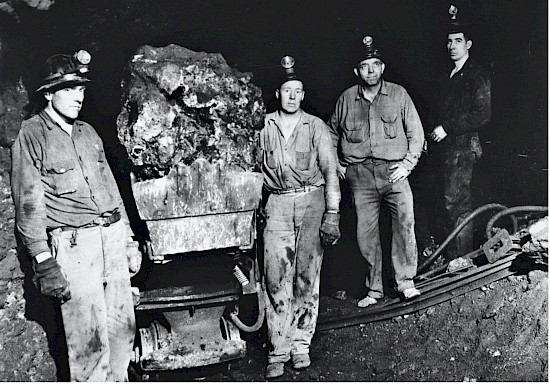
Mule and cart underground at Mammoth Mine, circa 1920’s
Photos courtesy of Tintic Historical Society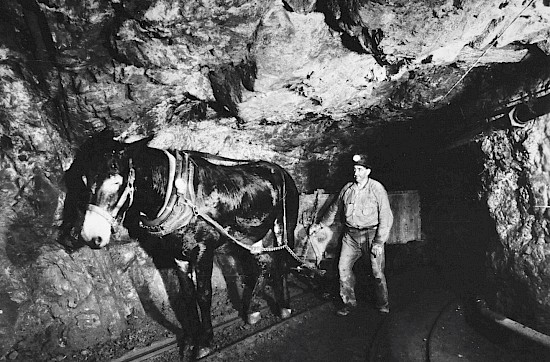
Miners at Mammoth Mine, circa early 1900’s
Photos courtesy of Tintic Historical Society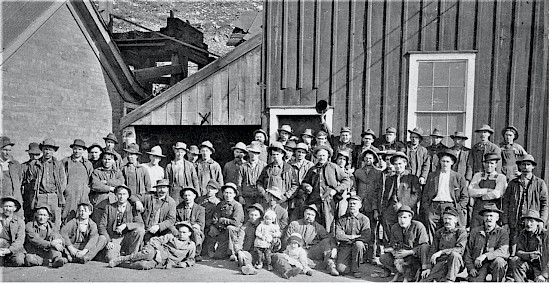
Qualified Persons
Disclosures of a scientific or technical nature included in this news release, including the sampling, analytical and technical data underlying the information, have been reviewed, verified, and approved by Charles N. Forster, P.Geo., a Qualified Person as defined by Regulation S-K, Subpart 1300 promulgated by the U.S. Securities and Exchange Commission and by Canadian National Instrument 43-101. Mr. Forster is an employee of Ivanhoe Electric.
Ivanhoe Electric has prepared an independent technical report summary for the Tintic Project prepared under SEC Regulation S-K, Subpart 1300 and an independent technical report prepared under Canadian Instrument NI 43-101. These reports are available on the company’s website, on EDGAR and under the company’s SEDAR profile:
- “SEC Technical Report Summary, Exploration Results Report, Tintic Project, Utah, U.S.A.” prepared by SRK Consulting U.S., Inc. (“SRK”) with an effective date of May 5, 2021.
- “NI 43-101 Technical Report: Mineral Project Exploration Information, Tintic Project, Utah, USA” prepared by SRK with an effective date of May 5, 2021
The technical report summary and technical report include relevant information regarding data verification, exploration procedures and other matters relevant to the scientific and technical disclosure contained in this news release.
About Ivanhoe Electric
Ivanhoe Electric is an American technology and mineral exploration company that is re-inventing mining for the electrification of everything by combining advanced mineral exploration technologies, renewable energy storage solutions and electric metals projects predominantly located in the United States. Ivanhoe Electric uses its Typhoon™ transmitter, an accurate and powerful geophysical survey system, together with advanced data analytics provided by its subsidiary, Computational Geosciences, to accelerate and de-risk the mineral exploration process as well as to potentially discover deposits of critical metals that may otherwise be undetectable by traditional exploration technologies. Through its controlling interest in VRB Energy, Ivanhoe Electric also develops and manufactures advanced grid-scale vanadium redox battery storage systems. Finally, through advancing its portfolio of electric metals projects located primarily in the United States, headlined by the Santa Cruz Copper Project in Arizona and the Tintic Copper-Gold Project in Utah, as well as projects in Montana, Oregon and North Carolina, Ivanhoe Electric is also well positioned to support American supply chain independence by delivering the critical metals necessary for electrification of the economy.
Information Contact
Investors
Evan Young, Vice President of Corporate Development
604-689-8765
Valerie Kimball, Director of Investor Relations
720-933-1150
Forward-looking statements
Certain statements in this news release constitute “forward-looking statements” or “forward-looking information” within the meaning of applicable U.S. and Canadian securities laws. Such statements and information involve known and unknown risks, uncertainties and other factors that may cause the actual results, performance or achievements of the company, its projects, or industry results, to be materially different from any future results, performance or achievements expressed or implied by such forward-looking statements or information. Such statements can be identified by the use of words such as “may”, “would”, “could”, “will”, “intend”, “expect”, “believe”, “plan”, “anticipate”, “estimate”, “scheduled”, “forecast”, “predict” and other similar terminology, or state that certain actions, events or results “may”, “could”, “would”, “might” or “will” be taken, occur or be achieved. These statements reflect the company’s current expectations regarding future events, performance and results and speak only as of the date of this news release.
Such statements include without limitation statements regarding: (i) future exploration drill programs; and (ii) that anomalies may be the porphyry targets that have produced all of the copper and precious metals in the historic Tintic District.
Forward-looking statements are based on management’s beliefs and assumptions and on information currently available to management. Such statements are subject to significant risks and uncertainties, and actual results may differ materially from those expressed or implied in the forward-looking statements due to various factors, including changes in the prices of copper or other metals Ivanhoe Electric is exploring for; the results of drilling and exploration activities and/or the failure of exploration programs or studies to deliver anticipated results or results that would justify and support continued exploration, studies, development or operations; the significant risk and hazards associated with any future mining operations, extensive regulation by the U.S. government as well as local governments; changes in laws, rules or regulations, or their enforcement by applicable authorities; the failure of parties to fulfill contracts with the company or to perform as agreed; and the impact of political, economic and other uncertainties associated with operating in foreign countries, and the impact of the COVID-19 pandemic and the global economy. These factors should not be construed as exhaustive and should be read in conjunction with the other cautionary statements described in Ivanhoe Electric’s registration statement on Form S-1, as amended, filed with the U.S. Securities and Exchange Commission and base PREP prospectus filed with Canadian securities commissions.
No assurance can be given that such future results will be achieved. Forward-looking statements speak only as of the date of this news release. Ivanhoe Electric cautions you not to place undue reliance on these forward-looking statements. Subject to applicable securities laws, the company does not assume any obligation to update or revise the forward-looking statements contained herein to reflect events or circumstances occurring after the date of this news release, and Ivanhoe Electric expressly disclaims any requirement to do so.



